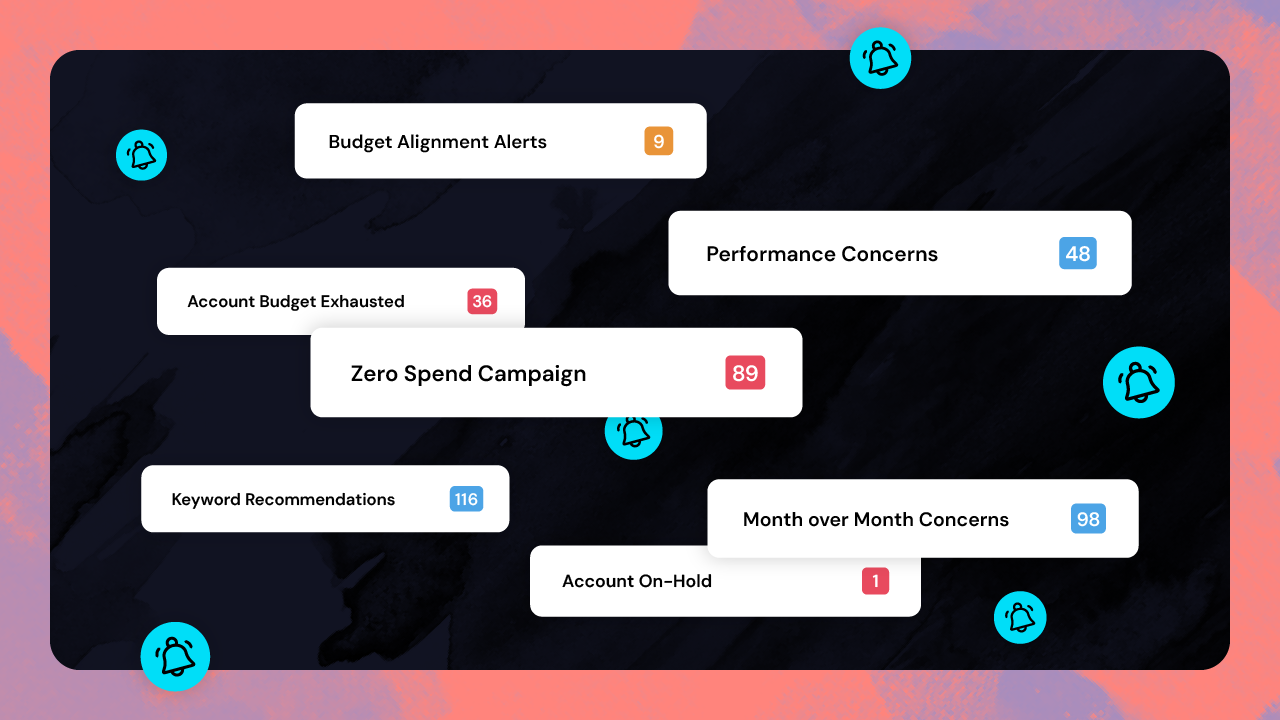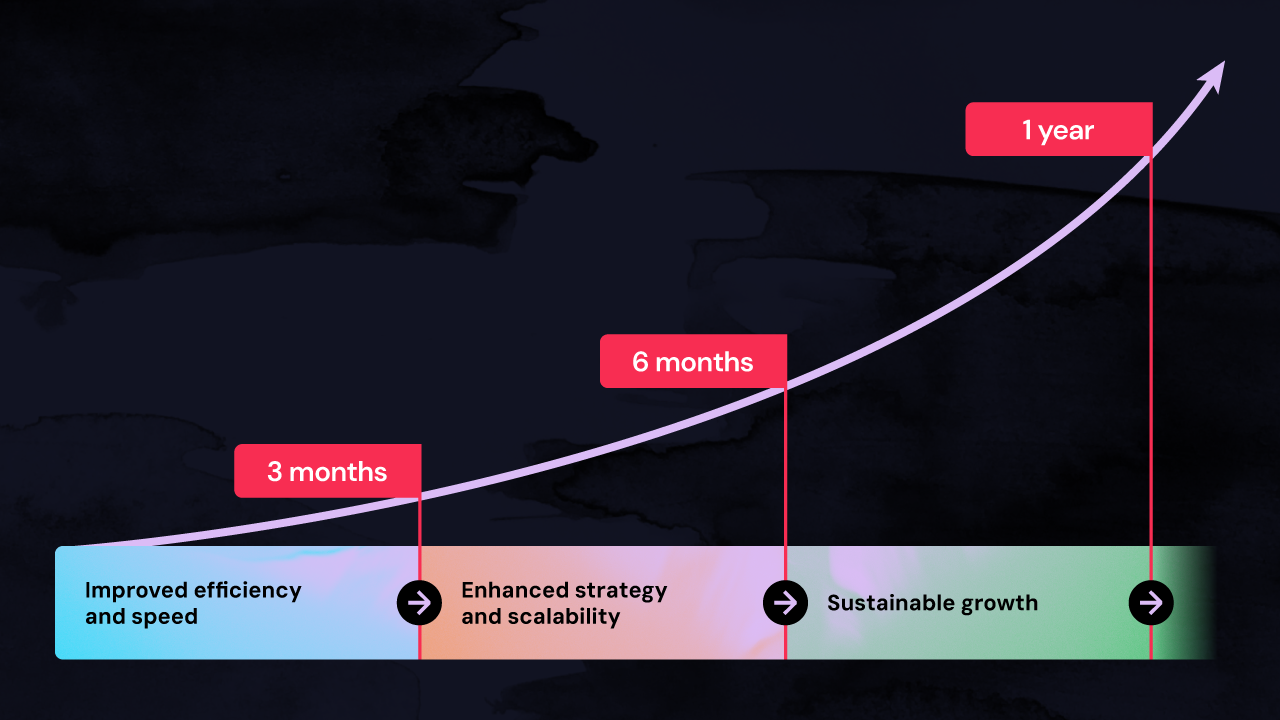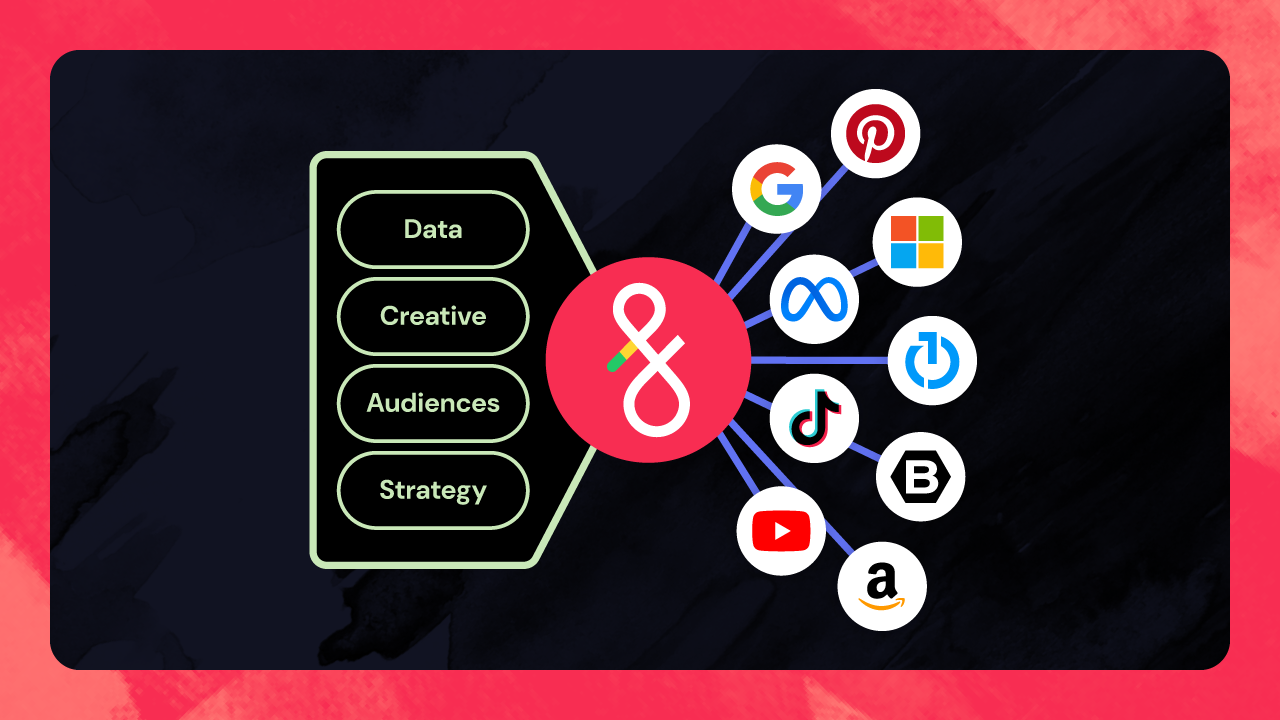In large advertising organizations where you're supporting ever-growing account portfolios, losing clients due to poor ad performance isn't an option…but neither is having your team burn hours (and labor costs) on routine AdOps tasks. That’s why a multichannel advertising notification system is essential to your operations.
Automated advertising alerts help teams catch issues before they become costly problems. They can also serve as your team’s proactive to-do list. Instead of investing time every day on a scavenger hunt chasing down potential errors, notifications bring issues forward before they become major problems. This saves your team valuable time they'd otherwise spend manually digging for errors.
The best advertising notification systems deliver alerts that directly impact your bottom line and client retention. Here are seven essential notifications every enterprise advertiser needs to reduce risk and control costs.
1. Zero spend accounts/campaigns alerts
Why it matters: For enterprise clients, even a single “zero spend” day can translate to thousands of dollars in lost conversions. The zero spend account/campaigns alerts notify your team when a campaign or account with a flighted budget isn’t spending, helping you mitigate missed opportunities and lost revenue.
A campaign with an approved budget that isn't spending could signal several critical issues: a disapproved ad, a budget cap being hit, or even a missing image. By alerting your team that a campaign or account isn’t spending, they can quickly investigate and resolve the root cause.
Example: You recently launched “lease-up” campaigns for a multifamily client with several new communities opening this quarter. Midway through the week, a zero spend account notification pops up for one of the properties.
Your team finds that the campaign budget was set correctly, but the ad groups were paused during a creative refresh and never reactivated. This alert helps your team re-enable the ads with the updated creative, preventing days of lost exposure for a high-priority campaign.
2. Disapproved ads and ad extensions notifications
Why it matters: The disapproved ads/ad extensions notification ensures that every ad in your entire customer portfolio is live and compliant, minimizing downtime and protecting client relationships.
If you’re managing ad campaigns at an enterprise scale, a disapproved ad could go unnoticed for days. Disapproved ads can severely damage campaign performance due to lost impressions or a Quality Score drop. (Plus, don’t be surprised to get a heated client call asking why their ads are no longer running.) Simply put, this alert is vital for risk mitigation, alerting your team to disapproved ads across all major ad channels.
Example: One of your restaurant franchise clients wants to run a regional promotion for their spicy chicken sandwich. Many ad platforms, including Google Ads, require that any time-sensitive or location-dependent offers include disclaimers like “Price and participation may vary by location” or “For a limited time only.”
A few of the ads the client submitted to your agency didn’t include these pricing, offer, and availability disclaimers. Google disapproved the ads due to misrepresentation. The disapproved ad notification notifies your team of these disapprovals right away so they can add the missing disclaimers and resubmit the ads.
3. Notifications for Google Verification Requests
Why it matters: This alert exemplifies how proactive notifications protect your clients and your agency. Google sometimes requires account owners to re-verify their accounts to minimize account hacks. This can cause headaches for enterprise ad agencies because ad account owners are typically your clients. In other words, your clients need to quickly respond to Google’s verification requests to keep ads running. However, if they miss Google’s email, the account can be suspended.
The Google Verification Request alert notifies your team when Google sends these requests to account owners. This early warning allows your team to reach out to the client, guide them through the verification process, and prevent account suspension.
Example: Your agency gets a Google Verification Request notification for a key client. Once alerted, your team reaches out to the client, asking them to check their inbox and click the verification link. This simple, proactive step avoids the all-too-common scenario where an account is suspended and a client calls asking, "Why aren't my ads showing anymore?"
4. Advertising performance concern alerts
Why it matters: Nothing drives up overhead costs like having teams manually scour hundreds of campaigns for performance improvement opportunities. This alert slashes labor costs by bringing critical issues directly to the right account manager.
First, your team sets defined “performance bounds” around client-specific benchmarks. Whenever performance dips below the lowest threshold, the account manager is sent a performance concern notification so they can investigate why a campaign or account is underperforming. This alert is the ultimate time-saver, allowing strategists to focus on high-level strategies instead of hunting for problems.
Example: A legal client’s performance bounds are set to alert you if the CPC goes above $5.50 for critical keywords. When an alert comes in that the CPC increased to $6 for one of the client’s keywords, your team can jump in and determine the best course of action.
Whether it’s a competitor raising bids or a change in search trends, this notification alerts your team before spend kicks into overdrive. Your team can make fast, informed decisions about how to maintain profitability and protect the client's ROI based on what they think is best.
5. Notifications for destination URL problems
Why it matters: Landing page errors, such as 404s or server issues, can derail campaign performance by preventing users from reaching the intended destination. These errors waste ad spend and can drive down Quality Scores, resulting in higher CPCs and reduced ad visibility.
The destination URLs with problems notification ensures your team is immediately alerted to any landing page issues, allowing them to resolve errors so your ad clicks land where they should.
Example: A client is running a limited-time holiday promotion campaign. Partway through the campaign, a notification flags that one of the ad group’s destination URLs is returning a 404 error. Thanks to the alert, your team tracks down the right URL and has everything up and running in minutes. The campaign continues driving traffic to the correct page without losing valuable conversions.
6. Account synchronization error alerts
Why it matters: Data accuracy is critical for enterprise advertisers to make informed decisions and maintain client trust. Losing access to an account's data source (for example, when an API connection to Google Ads or Meta breaks) causes your data to become outdated or incomplete.
The account synchronization error notification is a crucial operational health check, keeping your team aware of any data source syncing issues. This allows them to quickly investigate and resolve problems, ensuring the data they rely on for reporting and optimization remains fresh, reliable, and accurate.
Example: It’s the end of the month and your team is about to pull a monthly performance report for a key client. A notification pops up saying that the client’s API connection to Meta Ads failed overnight, meaning your current Meta Ads dataset is incomplete.
The alert prompts your team to reconnect the account, ensuring the report is accurate and delivered on time. Without this notification, the error might have gone unnoticed, resulting in incorrect insights that could potentially impact next month’s strategic decisions.
7. Out-of-country advertising spend alerts
Why it matters: It’s hard to imagine your team would accidentally run ads in the wrong country. But manually managing enterprise-scale ad campaigns means a lot can slip through the cracks.
The out-of-country spend notification is one of many risk mitigation alerts that help teams easily avoid unnecessary spend errors. This alert flags teams when a campaign is spending in the wrong countries, often due to misconfigured location settings (e.g., targeting "People interested in your location" instead of "People in your location").
Catching these issues early ensures campaign budgets are focused on the right audience, saving your clients from paying for irrelevant clicks.
Example: A healthcare client is running a campaign targeting consumers in the United States. A notification alerts your team that the campaign is spending in Canada due to a misconfigured location setting. Your team quickly adjusts the targeting parameters to stop the out-of-country spend, keeping the client’s US-based campaign on track to meet its goals.
Turning alerts into action with automated AdOps notifications
A robust multichannel notification system is so much more than a convenient way to manage enterprise-scale ad campaigns. With the right notifications, your AdOps team can proactively address issues before they escalate into costly problems.
Advertising notifications are a reliable way to both mitigate risk and improve performance, all while reducing wasteful manual work. Paired with a proactive support and optimization methodology, automated alerts can help your team focus on what truly matters: driving results and delivering value for your clients.
FAQ: automated multichannel advertising notifications
1. What are multichannel advertising notifications?
Multichannel advertising notifications are real-time alerts that flag critical issues across multiple ad platforms, including Google Ads, Meta Ads, and programmatic DSPs like Basis. A Digital Advertising Operating System (DAOS) can pull in need-to-know alerts from multiple publishers into one system. This helps teams proactively address problems like disapproved ads, zero spend campaigns, or account synchronization errors across multiple channels simultaneously, ensuring campaigns run smoothly 24/7.
2. How do multichannel notifications reduce risk for advertisers?
Real-time alerts for issues like out-of-country spend or Google verification requests, multichannel notifications allow teams to act quickly and prevent costly problems. This proactive approach minimizes downtime, protects ad performance, and reduces the risk of client dissatisfaction.
3. Can multichannel notifications save time for AdOps teams?
Yes! Multichannel notifications eliminate the need for manual monitoring by automatically serving key issues to the strategists or team members who can address them. With notifications, AdOps teams don’t have to spend hours searching for errors across different platforms. They can focus on high-level strategy work and spend time with clients: two workflows that humans do best. In fact, our latest data found that teams spend 51% less time on weekly campaign updates when using automated tools like notifications.
4. Can advertising notifications help identify performance issues early?
Yes! For example, Fluency’s Digital Advertising Operating System includes both daily and monthly performance health notifications that flag underperforming ads (e.g., when a client’s KPIs dip below or rise above their customized performance targets).
These insights help teams quickly take corrective action for optimal campaign outcomes without jumping around different platforms looking for performance dips every few days. Most importantly, notifications can help you catch any issues before monthly spend is impacted, which also helps agencies avoid issuing client credits.
5. How do multichannel notifications help prevent outdated ads from running?
Notifications can alert teams when ads with expired messaging, such as past holiday promotions or outdated offers, are still running. These automation-powered alerts help enterprise ad teams keep client campaigns relevant and compliant, making sure budget isn’t wasted and brands uphold their credibility.
6. How do automated notifications improve budget oversight for enterprise advertisers?
Budget-related notifications, like budget reallocation recommendations, help teams optimize spend by identifying opportunities to shift budgets based on performance metrics like cost-per-conversion or click-through rates. This gives teams full control to use budgets efficiently across multichannel campaigns without the risk of manually moving money from place to place.






